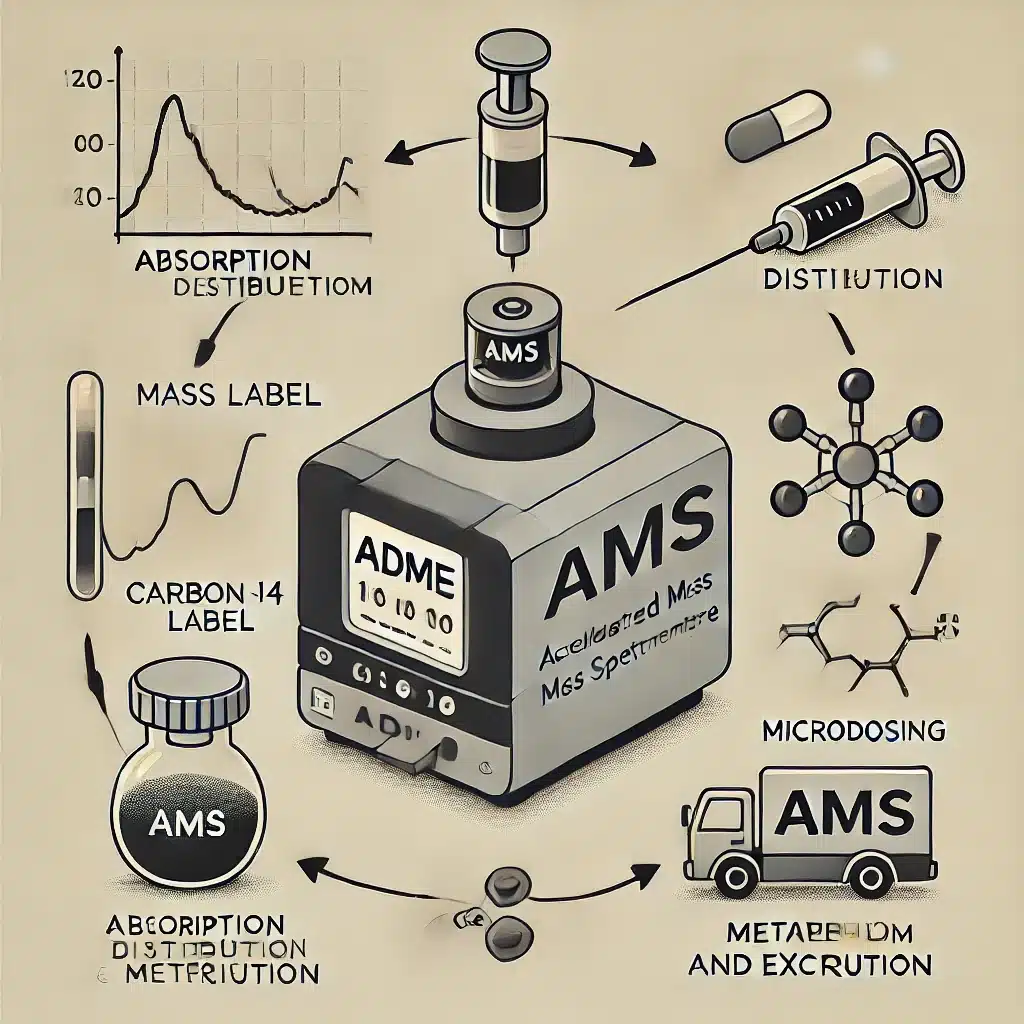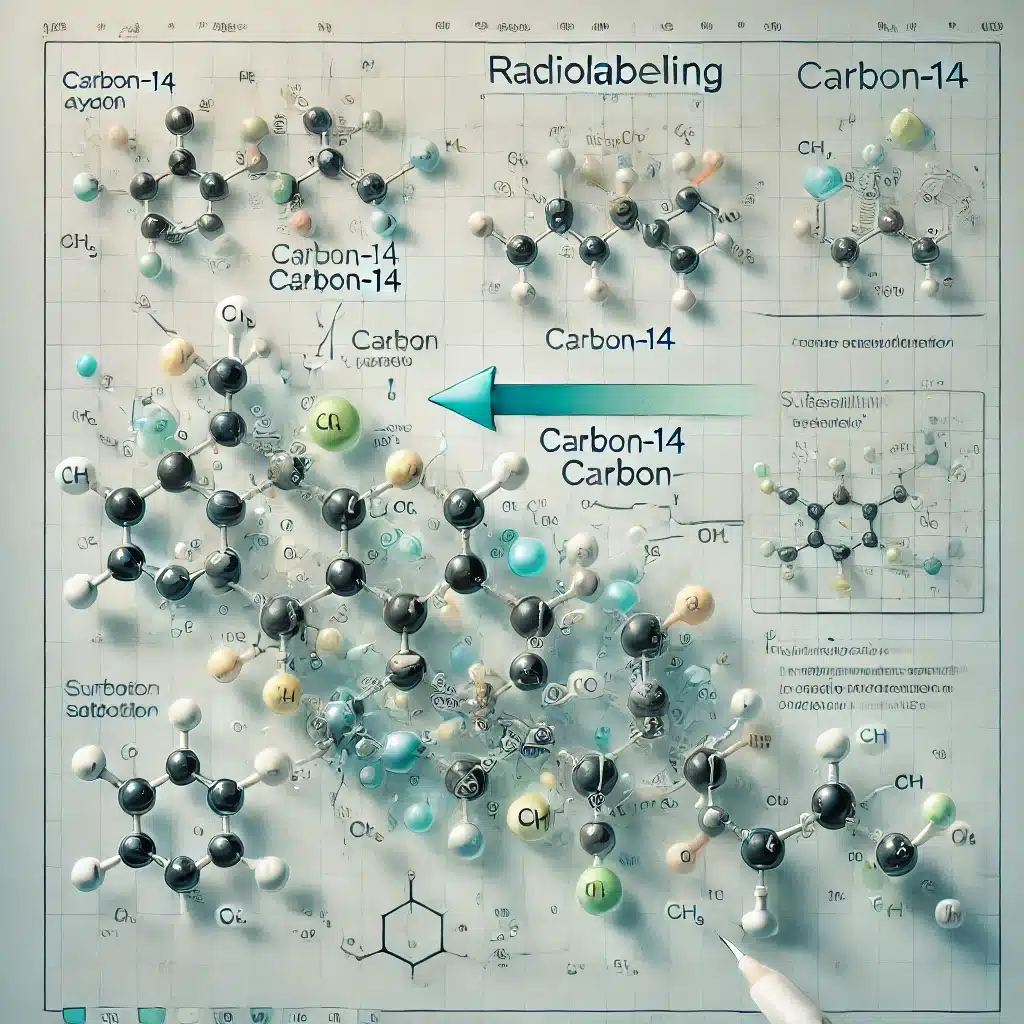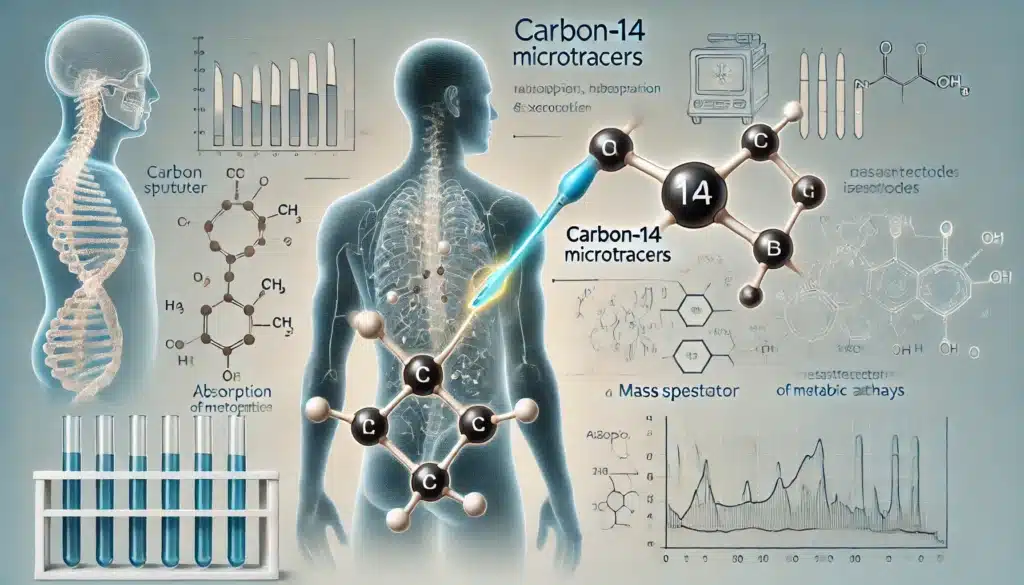Summary: The use of carbon-14 (14C) labelled active pharmaceutical ingredients (APIs) in drug metabolism studies provides a powerful tool for understanding the pharmacokinetics and biotransformation of drug compounds. These studies help assess the absorption, distribution, metabolism, and excretion (ADME) of drugs, supporting safer and more effective drug development. This article discusses the principles, methodology, applications, and regulatory aspects of using Carbon-14 Labelled APIs, highlighting their essential role in the pharmaceutical industry for determining the safety and efficacy of new drugs.
Introduction to Carbon-14 Labelling in Drug Development
Drug metabolism studies are crucial in the development and approval process of new pharmaceutical compounds. Carbon-14 labelling, one of the most reliable radioactive tracing methods, involves substituting a carbon atom within the molecule with the isotope carbon-14, a process that aids in tracking the metabolic pathways of the drug. Due to its predictable half-life and negligible influence on the chemical properties of the molecule, carbon-14 has become the preferred isotope in pharmacokinetic and drug metabolism studies. By following the distribution of 14C-labelled APIs in biological systems, researchers can obtain valuable data about the ADME characteristics of drugs.
The Importance of ADME Studies in Drug Development
Understanding the ADME properties of a drug is essential for assessing its therapeutic efficacy and potential toxicity. These studies address:
- Absorption: Determines how a drug is absorbed into the bloodstream after administration.
- Distribution: Explores how the drug disperses within body compartments.
- Metabolism: Identifies metabolic pathways and possible bioactive or toxic metabolites.
- Excretion: Observes how the drug and its metabolites are eliminated from the body.
14C-labelled APIs enable researchers to follow the journey of the drug through these stages, helping to pinpoint specific metabolic pathways and identify possible accumulation in certain tissues. This information supports decisions on dosage, formulation, and safety assessments in the drug development pipeline.
Principles of Carbon-14 Labelling
Carbon-14 is a radioactive isotope with a half-life of approximately 5,730 years, which provides stable and measurable radioactivity over long-term studies. Labelling an API with 14C typically involves substituting one or more stable carbon atoms in the molecule with carbon-14. The radioactive decay of 14C emits low-energy beta particles, which can be detected and quantified to provide precise data on the compound’s location and concentration.
The position of the 14C atom within the API’s molecular structure is chosen carefully to ensure it remains intact during metabolic reactions. Label placement should avoid easily cleavable groups, which would otherwise complicate the detection of metabolites and disrupt accurate ADME profiling.
Synthesis of Carbon-14 Labelled APIs
The synthesis of 14C-labelled APIs is a specialised area within radiochemistry, requiring meticulous planning and execution. Key considerations include:
- Synthetic Route Selection: The synthesis pathway must preserve the integrity of the 14C label while yielding the target compound in sufficient quantity and purity. Reactions are designed to ensure that the label remains at a stable position, often through multi-step organic synthesis.
- Yield and Purity: Due to regulatory and scientific requirements, the final product must be highly pure, with radiochemical purity often exceeding 95%. Yield efficiency is particularly crucial given the cost and limited availability of 14C-labelled precursors.
- Handling and Safety: Radioactive materials demand strict safety protocols. Laboratories that synthesise 14C-labelled APIs follow rigorous handling, storage, and waste disposal procedures to protect researchers and the environment from radiation exposure.
Methodologies in Drug Metabolism Studies Using 14C-Labelled APIs
In Vitro Studies
In vitro studies are typically conducted in cell cultures, microsomes, or tissue homogenates to examine the early-stage metabolism of the drug. These models, including human liver microsomes, provide an initial look into the enzymatic pathways that metabolise the drug. The 14C-labelled API allows direct quantification of parent compounds and metabolites without the need for additional complex detection methods.
In Vivo Studies
In vivo studies are conducted in animal models or human subjects, depending on the stage of development. These studies involve administering the 14C-labelled API and monitoring the compound’s distribution and elimination over time. Samples of blood, urine, faeces, and tissue biopsies are analysed to track the location and concentration of the label, providing a comprehensive understanding of the drug’s pharmacokinetics in a living system.
Quantitative Whole-Body Autoradiography (QWBA)
QWBA is an imaging technique that enables the visualisation of radioactivity distribution in an entire body, commonly used in animal studies. This method provides spatial and temporal information about the drug’s localisation in organs and tissues. QWBA can identify any areas where the drug might accumulate, which can be crucial for assessing potential toxicity.
Metabolite Profiling and Identification
Using chromatographic and mass spectrometric methods combined with radio-detection, researchers can separate and identify drug metabolites. Metabolite profiling with 14C-labelled APIs is essential for ensuring that no toxic or active metabolites form in significant amounts, which could impact the drug’s safety and efficacy.
Applications of Carbon-14 Labelled APIs in Drug Development
Clinical Mass Balance Studies
Clinical mass balance studies, often called ADME studies, are designed to determine the recovery of the drug and its metabolites from excreta (urine and faeces). 14C-labelled APIs are ideal for these studies as they provide quantitative data on the drug’s fate in the body. This information is essential for understanding the elimination pathways, especially for compounds that may have complex metabolic routes.
Drug-Drug Interaction Studies
Drug-drug interactions (DDIs) are a major concern, especially in patients taking multiple medications. 14C-labelled APIs help in assessing the potential interactions of the investigational drug with other co-administered drugs. This data is critical for evaluating the potential for adverse effects due to enzyme inhibition or induction, which could alter the pharmacokinetics of the drugs involved.
Pharmacokinetic Studies
Pharmacokinetic (PK) studies using 14C-labelled APIs provide critical data on the time-dependent movement of the drug in the body. By calculating parameters such as the half-life, maximum concentration, and time to reach maximum concentration, researchers can tailor dosing regimens to optimise efficacy and minimise adverse effects.
Preclinical Toxicology Studies
Preclinical studies use 14C-labelled APIs to investigate potential toxic effects in animal models before advancing to human trials. These studies help identify toxic metabolites or tissue accumulation, providing early indicators of safety concerns that could be addressed before human exposure.
Regulatory Aspects of 14C-Labelled API Studies
Regulatory bodies such as the FDA, EMA, and MHRA mandate thorough ADME data for drug approval. The use of 14C-labelled APIs in drug metabolism studies is generally accepted and often recommended by these agencies. Specific regulations include:
- Good Manufacturing Practice (GMP): The production of 14C-labelled APIs must comply with GMP guidelines, ensuring quality and consistency in manufacturing processes.
- Clinical Trials Approval: For human studies, regulatory approval is required to ensure that the use of radioactive compounds meets safety standards. Each study involving a 14C-labelled API must justify the use of radiation and minimise exposure risk to patients.
- Environmental and Safety Compliance: Facilities conducting research with radioactive materials must comply with strict environmental and safety regulations. This includes proper disposal of radioactive waste and protection of research staff.
Challenges and Considerations in Using 14C-Labelled APIs
While 14C-labelled APIs are invaluable in drug metabolism studies, they come with specific challenges:
- Cost and Resource Intensive: The synthesis of 14C-labelled compounds is often costly and time-consuming, involving specialised expertise and equipment.
- Handling and Storage: Radiolabelled APIs require careful handling and specialised storage facilities to prevent radiation exposure and maintain stability over time.
- Ethical and Regulatory Constraints: Conducting studies involving radioactivity in humans requires ethical and regulatory approvals, which can extend timelines.
- Limited Isotope Supply: The production of carbon-14 is limited, making it a scarce and expensive resource. Researchers must plan its use strategically in drug development programmes.
Expanding the Use of 14C-Labelled APIs: Beyond Traditional Applications
The potential applications for 14C-labelled APIs extend beyond traditional ADME studies. Innovative approaches are emerging where 14C-labelled compounds contribute to our understanding of drug mechanisms, tissue-specific effects, and personalised medicine. For instance:
- Microdosing Studies: Carbon-14 labelled microdosing allows researchers to assess the pharmacokinetics of a drug in humans at sub-therapeutic doses, which minimises potential toxicity. This approach is especially useful in early-stage drug development, allowing researchers to gather human-specific PK data before full-scale clinical trials.
- Biomarker Discovery: By tracing 14C-labelled APIs and their metabolites, researchers can identify potential biomarkers for disease progression, treatment efficacy, or adverse effects. These biomarkers could be instrumental in developing companion diagnostics, aligning with the broader movement towards precision medicine.
- Investigating Drug Resistance: In fields like oncology and infectious disease, where drug resistance poses a significant challenge, 14C-labelled APIs can aid in studying how resistant cells metabolise or evade the drug. Understanding these metabolic adaptations may support the development of therapies that can overcome resistance.
- Evaluating Drug Formulations and Delivery Systems: With the rise of advanced drug delivery systems, such as nanoparticles and controlled-release formulations, carbon-14 labelling enables precise tracking of the drug’s release and absorption patterns. This data helps in optimising delivery systems for improved therapeutic outcomes.
Technological Advances Supporting 14C-Labelled API Studies
The continued evolution of analytical technologies is enhancing the efficiency and scope of 14C-labelled API studies. Some notable advancements include:
- Liquid Scintillation Counting (LSC): As a primary method for quantifying 14C in biological samples, LSC has seen improvements in sensitivity and speed, allowing researchers to analyse smaller samples with higher accuracy. This improvement reduces the radioactive dose required, enhancing the safety profile of studies involving human subjects.
- Accelerator Mass Spectrometry (AMS): AMS provides ultra-sensitive detection of 14C-labelled compounds, capable of quantifying even minute amounts of radioactivity. This sensitivity allows for ultra-low-dose studies, also known as microdosing, which has expanded the ethical and practical applications of radiolabelled studies in humans. AMS is particularly valuable for long-term studies where cumulative effects of low-dose exposure can be tracked.
- Advanced Imaging Techniques: The development of positron emission tomography (PET) combined with 14C-labelled compounds offers novel insights into drug distribution and tissue targeting. Although PET traditionally uses other isotopes, combining PET with 14C-labelled compounds may allow for dual-labelling techniques that capture both rapid distribution and longer-term metabolic profiling.
- High-Resolution Mass Spectrometry (HRMS): In combination with radiodetection, HRMS enables precise identification of drug metabolites, helping researchers profile the compound’s complete metabolic pathway. This integration with 14C-labelled APIs streamlines metabolite identification and improves data accuracy.
Ethical Considerations in Human Studies with 14C-Labelled APIs
Conducting studies with radioactive substances in humans, even at low doses, raises ethical considerations that require thorough scrutiny. The primary ethical concerns include:
- Minimising Radiation Exposure: Studies involving 14C-labelled compounds must adhere to the ALARA principle (As Low As Reasonably Achievable), ensuring that radiation exposure to participants is minimised. Protocols are carefully designed to balance the need for reliable data with safety considerations.
- Informed Consent: Participants in studies with 14C-labelled APIs must be fully informed of the nature of the radioactive exposure, potential risks, and study objectives. Clear communication is vital, especially for healthy volunteers in microdosing studies where therapeutic benefits are not directly anticipated.
- Regulatory Approval: Regulatory bodies require comprehensive documentation and justification for the use of radioactive compounds in human studies. Approval processes may involve extensive safety assessments, including dose calculations, risk analyses, and ethical evaluations.
Summary: The Indispensable Role of 14C-Labelled APIs in Modern Pharmacology
The use of carbon-14 labelled APIs in drug metabolism studies stands as an invaluable asset to modern pharmacology, allowing researchers to trace drug pathways with unparalleled precision. From preclinical studies in animal models to human clinical trials, 14C-labelled APIs provide comprehensive ADME data critical to assessing drug safety, efficacy, and potential for interaction. They enable pharmaceutical developers to optimise formulations, refine dosing regimens, and, ultimately, enhance therapeutic outcomes.
Although challenges such as high cost, handling complexity, and regulatory requirements exist, ongoing advances in analytical and imaging technologies promise to expand the applications and accessibility of 14C-labelled APIs. As drug discovery and development increasingly embrace personalised medicine and targeted therapies, the ability to trace drug metabolism and effects at a molecular level will become even more vital.
In the future, integration with emerging fields such as precision medicine, nanotechnology, and advanced imaging will likely broaden the role of 14C-labelled APIs. These compounds will remain a cornerstone of pharmacological research, supporting the development of safer, more effective therapies for a wide range of diseases. Through continuous innovation and adherence to ethical and regulatory standards, carbon-14 labelled APIs will continue to shape the landscape of drug metabolism studies, making them an indispensable tool in the pursuit of better medicines.
Disclaimer
The information presented in this article is intended for educational and informational purposes only. It does not constitute professional advice, diagnosis, or treatment. Open MedScience makes no representations or warranties of any kind, express or implied, about the completeness, accuracy, reliability, suitability, or availability of the information contained herein.
The discussion of carbon-14 labelled active pharmaceutical ingredients (APIs) and related methodologies reflects current scientific understanding and regulatory practices as of the publication date. However, practices, regulations, and interpretations may evolve, and readers are advised to consult appropriate experts or regulatory bodies for guidance on specific projects or compliance matters.
Any reference to clinical or preclinical applications involving radioactive materials must be carried out under strict ethical oversight and in accordance with local, national, and international laws and regulations. Open MedScience does not endorse or assume responsibility for any specific research practice or procedure undertaken by readers based on the contents of this article.
Use of radioactive substances, including carbon-14, requires specialised training, facilities, and approvals. Individuals or organisations undertaking such work are solely responsible for ensuring that all safety, legal, and ethical requirements are met.
You are here: home » diagnostic medical imaging blog »



